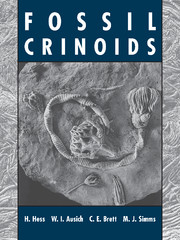Book contents
- Frontmatter
- Contents
- List of Contributors
- Acknowledgements
- Prelude
- Introduction
- GENERAL PART
- 1 Crinoid Form and Function
- 2 Systematics, Phylogeny and Evolutionary History
- 3 Fossil Occurrence
- 4 Taphonomy
- 5 Ecology and Ecological Interactions
- ASSEMBLAGES
- Appendix I Geological Time Table with Crinoid Assemblages
- Appendix II Glossary of Rocks
- Bibliography
- General Index
- Taxonomic Index
2 - Systematics, Phylogeny and Evolutionary History
Published online by Cambridge University Press: 10 November 2010
- Frontmatter
- Contents
- List of Contributors
- Acknowledgements
- Prelude
- Introduction
- GENERAL PART
- 1 Crinoid Form and Function
- 2 Systematics, Phylogeny and Evolutionary History
- 3 Fossil Occurrence
- 4 Taphonomy
- 5 Ecology and Ecological Interactions
- ASSEMBLAGES
- Appendix I Geological Time Table with Crinoid Assemblages
- Appendix II Glossary of Rocks
- Bibliography
- General Index
- Taxonomic Index
Summary
The phylum Echinodermata has been divided into two distinct subphyla – the Pelmatozoa, characterized by the possession of a stem, and the Eleutherozoa, which lack any trace of a stem. During the Palaeozoic there were many different pelmatozoan groups, including, among others, crinoids, blastoids, rhombiferans and diploporans. The non-crinoid pelmatozoans, commonly called blastozoans (Fig. 2), were most diverse and abundant during the Middle Ordovician, but crinoids reached their acme somewhat later, during the Early Carboniferous. By the end of the Permian, both crinoids and non-crinoid pelmatozoans suffered a catastrophic decline (Fig. 3). Crinoids were reduced to a single lineage surviving into the Early Mesozoic, while all blastozoans became extinct by the close of the Palaeozoic. In today's oceans, crinoids are the only surviving pelmatozoans, but there are four extant eleutherozoan classes – the Asteroidea, Ophiuroidea, Echinoidea and Holothuroidea.
Crinoids were first recognized as a distinct group of echinoderms by J. S. Miller in 1821. Previously, they had been grouped together with the asteroids. Numerous classification schemes have been developed since to explain relationships among the thousands of fossil and living crinoid species. The goal of all biological classification in the latter half of the twentieth century has been to reflect natural evolutionary groupings deduced from morphological similarity. However, morphological similarities commonly have evolved by convergent evolution and, if these convergent characters go unrecognized, the classification may not reflect true evolutionary relationships.
The most comprehensive and widely accepted classification scheme currently in use is that of the Treatise on Invertebrate Paleontology (Moore & Teichert 1978) (Table 1).
- Type
- Chapter
- Information
- Fossil Crinoids , pp. 31 - 40Publisher: Cambridge University PressPrint publication year: 1999
- 12
- Cited by



